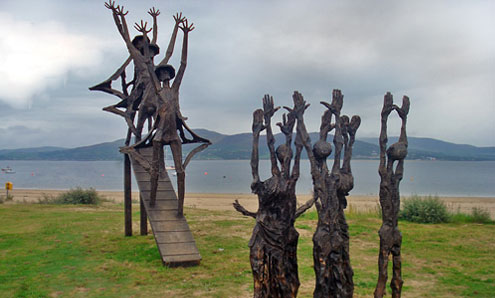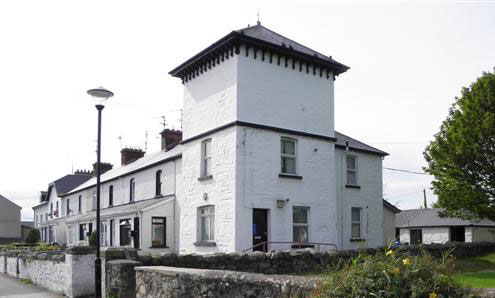





Rathmullan will always be know as the location from which the FLIGHT OF THE EARLS took place in the year 1607. Ninety nine people left from a small bay known as Portnamurray on the 14-9-1607. They included O'Neills, O'Donnells, O'Gallaghers, Maguires, McDevitts, McAward, Plunkett, McSweeney, O'Keenan, Tully and McGuinness.
They were bound for Spain but storms at sea blew them onto the French coast. They then headed for Rome. Only a party of 30 finally reached Rome on the 29-4-1608.
The Battery, (pictured above Left), was built in the year 1812 along with six other Batteries or Martello towers in Lough Swilly. The English built them in fear of a Napoleon invasion. The Batteries were kept manned up to the end of the First World War. The six towers formed what was called the Swilly Defences during the war and each had huge guns that protected the British Fleet as it lay at anchor in Lough Swilly, (above right) prior to or after crossing the Atlantic.
The battery is 40 feet high, is made of solid masonry and contained rooms for a garrison of thirty. This battery guarded the upper waters of the Swilly and it was also used as a balloon base during the war. It lay idle until the 1980's, when the Rathmullan Enterprise Group repaired the building and established a Heritage Centre which opened in 1990.

The Coastguard Station was built as a barracks to house the men who manned the Martello Towers. Beside the station is a field known as Flagpole Field.
It is where the flag was flown and every morning and evening there was a ceremony to raise and lower the British flag. It is still known today as Flagpole Field, but used as a football field. The Station remains in use today as A Garda Station and the living quarters have been changed into houses and called Coastguard Row.

Rathmullan Abbey was first built by the McSwiney's of Fanad, who were the local Chieftains, around 1518. It was first built as a priory for Carmelites and dedicated to the Blessed Virgin Mary. In 1595 the Abbey was plundered by Captain George Bingham from Sligo, and sacred vessels taken away.
In 1601, Captain Ralph Bingley took over the Abbey and used it as a barracks for his force of 150 men. In 1603 King James VI granted it to one James Fullerton. About 1617, Bishop Andrew Knox entered into possession, and converted the building into a palace for himself. The building was inhabited by the Knox family until the end of the century, after which it became derelict.